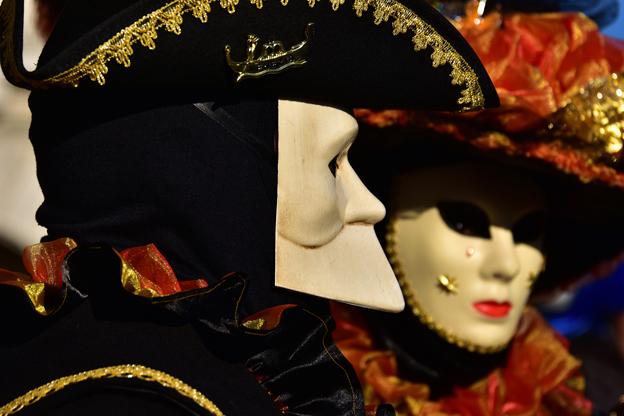Renaissance Venice: When It Was Always Carnival Time
ITA:

If you had walked around the calli of Venice in the 16th century, you would have noticed many Venetians wearing all sorts of masks and long, black, hooded capes. It would have been impossible to know who was behind them: a man or a woman, what their social status was, if it was someone famous or a complete stranger.
When these Venetians in disguise crossed paths, they greeted one another saying, “Buongiorno siora maschera,” Good morning, lady mask, and then they continued going their way.
At the time, the Venetian Carnival didn’t last just a few days; it was a celebration that went on for months. And the very democratic practice of wearing masks, which immediately canceled any difference in gender and social status, was common throughout the year.
The most classic and famous of Venetian masks is the bauta, which is entirely white; it covers the whole face, and has two holes for the eyes; it also alters the voice of the person wearing it, making for the perfect disguise. The fact that the bauta is open at the bottom, where the chin is, makes it possible to eat and drink without removing it, which means that it could be worn in any occasion.
The Council of Ten that ruled over Venice issued many decrees to restrict the use of masks, but people only followed them in a handful of situations: masks were avoided in churches and sacred places; prostitutes on the streets and their clients in the brothels were forbidden from wearing them; and nobody could wear one during epidemics such as the plague.
On the other hand, there were places where wearing a mask was not only allowed, but also encouraged: at the theater, for example, or at the casino. Gambling was widely practiced in Venice, a favorite pastime of the rich and poor alike. At some point during the 16th century, the Council of Ten issued a restrictive decree on gambling, limiting it to the Carnival period – which lasted for months anyway. Just as for masks, the decree wasn’t very successful, so, in an attempt to exercise more control and earn some revenue, the local government authorized, in 1638, the opening of the first official gambling room of the Republic of Venice; here, everybody wore masks except for the croupiers.
Venetians loved to party: balls and banquets were a daily affair, especially for the wealthy, and wearing masks and costumes during these occasions was customary.
Camminando per le calli di Venezia nel 16° secolo, avreste notato che molti veneziani indossavano maschere di ogni tipo e lunghi mantelli neri con cappuccio. Sarebbe stato impossibile sapere chi si celava dietro: se un uomo o una donna, quale fosse il loro status sociale, se si trattasse di un personaggio famoso o un perfetto sconosciuto.
Quando questi Veneziani in incognito si incrociavano per la strada, si salutavano dicendo, "Buongiorno siora maschera," e poi continuavano per la loro strada.
A quel tempo, il Carnevale di Venezia non durava solo pochi giorni; si trattava di una festa che andava avanti per mesi. E la pratica molto democratica di indossare maschere, che in un attimo cancellavano ogni differenza di genere e condizione sociale, era comune tutto l'anno.
La più classica e famosa delle maschere veneziane è la bauta, che è interamente bianca; essa copre tutto il viso, e ha due fori per gli occhi; inoltre, altera la voce della persona che la indossa, rendendo il travestimento perfetto. Il fatto che sia aperta verso il basso permette di mangiare e bere senza rimuoverla, il che significa che poteva essere indossata in ogni occasione.
Il Consiglio dei Dieci che governava Venezia emanò numerosi decreti per limitare l'uso di maschere, ma i cittadini li rispettavano solo in certe situazioni: le maschere andavano evitate in chiese e luoghi sacri; le prostitute per strada e i loro clienti nei bordelli non potevano indossarle; e nessuno poteva indossare una maschera durante le epidemie come la peste.
D'altro canto, c’erano luoghi dove indossare una maschera non era solo permesso, ma anche incoraggiato: a teatro, per esempio, o al casinò. Il gioco d'azzardo era ampiamente praticato a Venezia, il passatempo preferito di ricchi e poveri. Ad un certo punto durante il 16° secolo, il Consiglio dei Dieci emanò un decreto restrittivo sul gioco d'azzardo, che lo limitava al periodo di Carnevale - che in ogni caso durava mesi. Proprio come per le maschere, il decreto non ebbe molto successo, così, nel tentativo di esercitare un maggiore controllo e ottenere delle entrate, il governo locale autorizzò, nel 1638, l'apertura della prima sala da gioco ufficiale della Repubblica di Venezia; qui, tutti indossavano maschere, tranne i croupier.
I Veneziani amavano far festa: balli e banchetti avvenivano quotidianamente, soprattutto tra i ricchi, e indossare maschere e costumi in queste occasioni era consuetudine.











